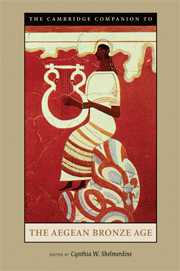Book contents
- Frontmatter
- 1 Background, Sources, and Methods
- 2 The Early Bronze Age in Greece
- 3 The Early Bronze Age in the Cyclades
- 4 Early Prepalatial Crete
- 5 Protopalatial Crete
- 6 The Material Culture of Neopalatial Crete
- 7 Minoan Culture: Religion, Burial Customs, and Administration
- 8 Minoan Crete and the Aegean Islands
- 9 Minoan Trade
- 10 Early Mycenaean Greece
- 11 Mycenaean Art and Architecture
- 12 Mycenaean States
- 13 Burial Customs and Religion
- 14 Mycenaean Greece, the Aegean and Beyond
- 15 Decline, Destruction, Aftermath
- Glossary
- Select Bibliography
- Index
- Plate section
2 - The Early Bronze Age in Greece
Published online by Cambridge University Press: 28 November 2010
- Frontmatter
- 1 Background, Sources, and Methods
- 2 The Early Bronze Age in Greece
- 3 The Early Bronze Age in the Cyclades
- 4 Early Prepalatial Crete
- 5 Protopalatial Crete
- 6 The Material Culture of Neopalatial Crete
- 7 Minoan Culture: Religion, Burial Customs, and Administration
- 8 Minoan Crete and the Aegean Islands
- 9 Minoan Trade
- 10 Early Mycenaean Greece
- 11 Mycenaean Art and Architecture
- 12 Mycenaean States
- 13 Burial Customs and Religion
- 14 Mycenaean Greece, the Aegean and Beyond
- 15 Decline, Destruction, Aftermath
- Glossary
- Select Bibliography
- Index
- Plate section
Summary
Introduction
The chronological span of this chapter is the late fourth, the third, and the early second millennium bce, i.e., the Final Neolithic, Early Helladic, and early Middle Helladic periods. The Early Helladic period was approximately 1000-1100 years in length, as long as the Middle and Late Helladic periods combined (Fig. 1.1). During the Early Bronze Age on the Greek mainland, small-scale complex societies emerged in a number of regions. This experiment in complexity held promise, but sweeping changes brought it to an end during the later part of the EH period. These changes have been connected with the “Coming of the Greeks” (that is, Indo-European speakers) as precursors to Mycenaeans of the later Bronze Age. This chapter surveys the archaeological data and interpretations of that data from the Greek mainland for the period spanning from the end of the Neolithic to the beginning of the Middle Bronze Age, including the problem of the “Coming of the Greeks” (below, pp. 38-41).
Study of the EH period began with Carl Blegen’s excavation at Korakou, near Corinth, in 1916-1918. The well-stratified remains allowed him to isolate ceramics of the various periods of the Bronze Age and, along with Alan Wace working at Mycenae, to devise a classification of the ceramics of the pre-Mycenaean period, the Early and Middle Bronze Ages. The excavation of several important sites with EH remains, such as Tiryns, Asea, and Zygouries, contributed additional information, especially about architecture. The picture of the EH period changed fundamentally, however, with the excavation of Lerna in the 1950s.
- Type
- Chapter
- Information
- The Cambridge Companion to the Aegean Bronze Age , pp. 19 - 46Publisher: Cambridge University PressPrint publication year: 2008
- 20
- Cited by



